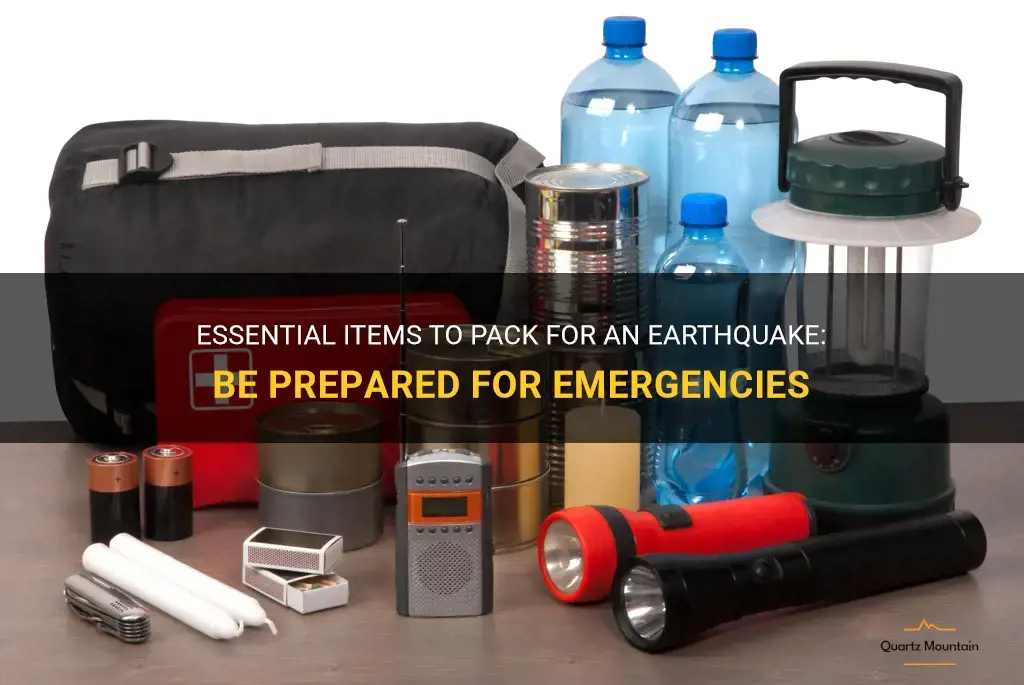
The ground begins to shake violently, buildings crumble, and panic ensues. Earthquakes can strike suddenly and wreak havoc on communities, leaving behind a trail of destruction. In such a disaster, being prepared is crucial, and one way to ensure survival is by having essential items packed and ready. From first aid supplies to emergency food and water, being equipped with the right tools can make all the difference in the face of an earthquake. So, are you ready to learn about the essential items that could save your life during an earthquake? Let's dive in and explore what it takes to be prepared for emergencies.
| Characteristics | Values |
|---|---|
| Water | 1 gallon per person |
| Non-perishable food | 3-day supply |
| Medications | 7-day supply |
| First aid kit | Basic supplies |
| Flashlight | Extra batteries |
| Portable radio | Extra batteries |
| Whistle | For signaling |
| Dust mask | For air filtration |
| Moist towelettes | For hygiene |
| Wrench or pliers | To turn off utilities |
| Can opener | Manual type |
| Cash | In small bills |
| Important documents | Copies in waterproof container |
| Cellphone | With chargers |
| Personal hygiene items | Soap, toothpaste, etc. |
| Plastic bags | For trash/waste |
| Sleeping bag | Or warm blankets |
| Change of clothing | For each person |
| Tools | Multi-purpose and/or Swiss army knife |
| Local map | For navigation |
| Local contact information | In case of separation |
| Extra eyeglasses | If needed |
| Infant formula and diapers | If needed |
| Pet supplies | If needed |
| Entertainment items | Books, games, etc. |
What You'll Learn
- What are the essential items to include in an earthquake emergency kit?
- Is it necessary to include food and water in the emergency kit, and if so, how much should be packed?
- Should any specific medications or medical supplies be included in the emergency kit for an earthquake?
- Are there any tools or equipment that should be included in the emergency kit for potentially clearing debris or opening doors?
- What type of clothing or personal protective equipment should be packed in case of an earthquake?

What are the essential items to include in an earthquake emergency kit?
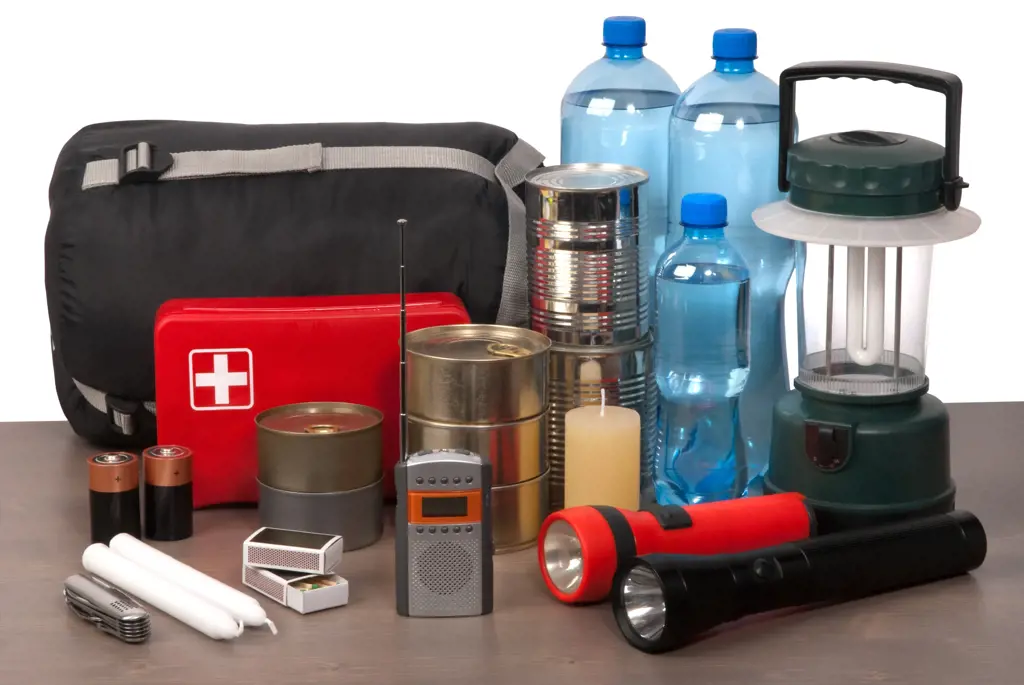
An earthquake emergency kit is an essential part of being prepared for a natural disaster. When an earthquake strikes, it can cause widespread damage and chaos, making it crucial to have all necessary supplies on hand. By having a well-equipped emergency kit, you can ensure the safety and well-being of yourself and your loved ones during this highly stressful time.
Here is a step-by-step guide on what essential items to include in your earthquake emergency kit:
- Water: The most important item to have in your emergency kit is water. It is recommended to have at least one gallon of water per person per day for at least three days. This water can be used for drinking, cooking, and personal hygiene.
- Food: Non-perishable food items are essential to have in your emergency kit. Include canned goods, energy bars, and other high-calorie foods that can provide sustenance in case of an extended period without electricity or access to fresh food.
- Medications: If you or any family members are on prescription medications, make sure to have a supply on hand in your emergency kit. Additionally, include basic over-the-counter medications such as pain relievers, antacids, and cold medicine.
- First aid kit: A well-stocked first aid kit can be a lifesaver during an earthquake. Include items such as bandages, gauze, adhesive tape, antiseptic wipes, scissors, and tweezers. It is also advisable to include a first aid manual to guide you in case of any injuries.
- Flashlights and batteries: Power outages are common during earthquakes, so it is important to have flashlights with extra batteries. Make sure to check the batteries periodically to ensure they are still functional.
- Whistle: A whistle can be used to attract attention and signal for help. Make sure each member of your family has one in their emergency kit.
- Portable phone charger: Keep a portable phone charger in your emergency kit so that you can charge your phone even if there is no electricity. This will allow you to stay connected and communicate with emergency services or loved ones.
- Personal hygiene items: Include items such as toilet paper, wet wipes, hand sanitizer, and feminine hygiene products in your emergency kit. These items can help maintain hygiene and prevent the spread of bacteria and disease.
- Cash and important documents: Keep a small amount of cash in your emergency kit, as ATMs and banks may be inaccessible during an earthquake. It is also wise to have copies of important documents such as identification cards, passports, insurance policies, and contact information in case you need to leave your home suddenly.
- Blankets and extra clothing: Include warm blankets and extra clothing in your emergency kit. Earthquakes can cause damage to buildings, leading to loss of heating or shelter, so it is important to have warm clothing and bedding to stay comfortable.
- Tools and supplies: Include items such as a multipurpose tool, duct tape, plastic sheeting, a can opener, and a fire extinguisher. These tools can be handy for various tasks during and after an earthquake.
- Entertainment items: To keep spirits high during a potentially stressful situation, include some entertainment items such as books, playing cards, or small games.
It is important to regularly review and update your earthquake emergency kit to ensure that all items are still functional and have not expired. Keep your emergency kit in an easily accessible location, such as near an exit, so that you can quickly grab it in case of an earthquake. Being prepared with an earthquake emergency kit can make a significant difference in your ability to cope with and recover from a seismic event.
The Ultimate Guide: Mastering the Art of Packing a Suitcase
You may want to see also

Is it necessary to include food and water in the emergency kit, and if so, how much should be packed?
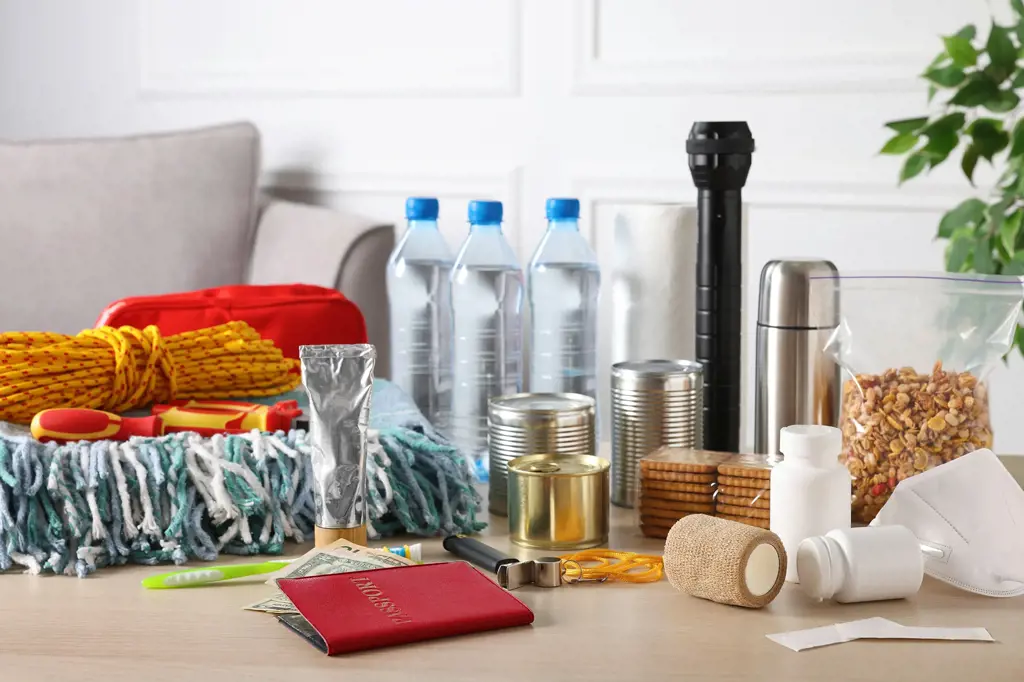
In any emergency situation, having a well-stocked emergency kit is essential. While many people understand the importance of including items such as first aid supplies and flashlights, some may wonder if it is necessary to include food and water in the kit as well. The answer to this question is a resounding yes. Both food and water are critical for sustaining life, especially during an emergency when access to these resources may be limited. In this article, we will explore why it is important to include food and water in an emergency kit and provide tips on how much should be packed.
When an emergency occurs, such as a natural disaster or a power outage, access to clean food and water may become scarce. Supermarkets may be closed or their supplies may be limited, leaving individuals without the means to obtain sustenance. In situations like these, having food and water readily available in an emergency kit can be a lifesaver. Additionally, some emergencies may require individuals to shelter in place for extended periods of time, making it even more crucial to have a reliable food and water supply.
When deciding how much food and water to pack in an emergency kit, it is important to consider the number of people who will be relying on the supplies. As a general rule of thumb, it is recommended to pack at least a three-day supply of food and water per person. This means having enough food and water to sustain each individual for three days. However, it is wise to err on the side of caution and pack additional supplies to account for unforeseen circumstances or delays in rescue efforts.
When it comes to selecting food items for an emergency kit, it is important to choose items that are non-perishable and require minimal preparation. Canned foods, granola bars, dried fruits, and nuts are all good options. It is also a good idea to pack a manual can opener, as many canned food items require one for access. For water, it is recommended to pack one gallon per person per day. This amount will cover both drinking and sanitation needs. It is also helpful to include water purification tablets or a portable water filter in case the water supply becomes compromised.
In addition to packing food and water, it is important to regularly check and replace these items in the emergency kit. Food items should be replaced every six months to ensure freshness and quality. Water should be replaced every year to maintain its safety. It is also a good idea to periodically review the emergency kit to make sure it contains an adequate amount of food and water for the current number of individuals relying on it.
In conclusion, including food and water in an emergency kit is absolutely necessary. During an emergency, access to these resources may become limited, making it crucial to have a reliable supply on hand. It is recommended to pack at least a three-day supply of food and water per person, selecting non-perishable food items and accounting for both drinking and sanitation needs. Regularly checking and replacing these items in the emergency kit is also important to ensure their freshness and safety. By taking these steps, individuals can be better prepared to face emergency situations with confidence and peace of mind.
Common Mistakes to Avoid When Packing Your Hospital Bag
You may want to see also

Should any specific medications or medical supplies be included in the emergency kit for an earthquake?
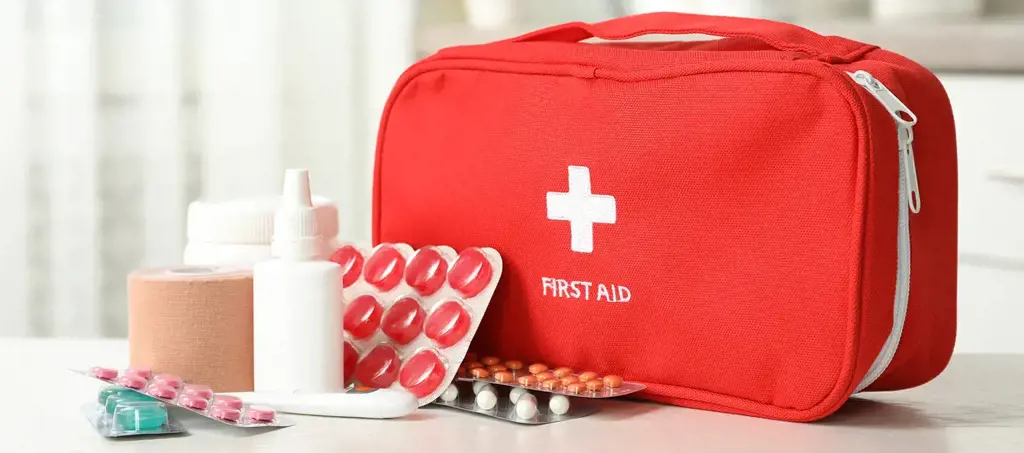
When preparing an emergency kit for an earthquake, it is important to include specific medications and medical supplies to ensure the safety and well-being of individuals. In the event of a natural disaster like an earthquake, access to medical facilities may be limited, making it crucial to have essential medications and supplies on hand. Here are some recommendations for what should be included in an emergency kit for an earthquake:
- Prescription Medications: If you or anyone in your household takes prescription medications, it is essential to include a supply for at least a week in your emergency kit. Make sure to rotate these medications regularly to ensure they do not expire.
- Over-the-Counter Medications: In addition to prescription medications, it is wise to include common over-the-counter medications in your emergency kit. These may include pain relievers, fever reducers, antacids, and allergy medications. Having these on hand can help alleviate symptoms that may arise during or after an earthquake.
- First Aid Supplies: It is crucial to have a well-stocked first aid kit in your emergency kit. This should include items such as adhesive bandages, gauze pads, adhesive tape, antiseptic wipes, tweezers, scissors, gloves, and a thermometer. These supplies can be used to administer basic first aid in the event of injuries caused by the earthquake.
- Personal Protective Equipment: Earthquakes can lead to hazardous conditions, such as broken glass and debris. It is essential to include personal protective equipment (PPE) in your emergency kit. This may include items such as goggles, gloves, and face masks to protect yourself and others from potential hazards.
- Hand Sanitizer and Wipes: Maintaining proper hygiene is crucial, especially during emergencies. Include hand sanitizer and disinfectant wipes in your emergency kit to ensure cleanliness and prevent the spread of germs.
- Emergency Contact Information: It is essential to have a list of emergency contact numbers readily available in your emergency kit. Include phone numbers for local hospitals, doctors, pharmacies, and your insurance provider. This information will be invaluable in case of medical emergencies or the need for prescription refills.
- Medical Identifications and Documents: Keep copies of medical identification cards, health insurance information, and any important medical documents in your emergency kit. These documents can provide vital information in case of evacuation or the need for medical attention.
It is crucial to regularly review and update your emergency kit to ensure that all medications and supplies are up to date and safe to use. Check expiration dates on medications and replace any expired items.
In addition to including medications and medical supplies in your emergency kit, it is also essential to have a plan in place for any medical conditions that may require specific care during an earthquake. For example, individuals with chronic illnesses or medical conditions should consult with their healthcare provider to develop an emergency plan tailored to their needs. This may include additional medications or specific instructions for managing their condition during an earthquake.
In conclusion, when preparing an emergency kit for an earthquake, it is important to include specific medications and medical supplies. Prescription medications, over-the-counter medications, first aid supplies, personal protective equipment, hand sanitizer, emergency contact information, and medical identifications should be included in the kit. Regularly review and update the emergency kit to ensure that all items are up to date and safe to use. Additionally, individuals with chronic illnesses should develop an emergency plan tailored to their specific needs. By taking these precautions, individuals can ensure their safety and well-being during earthquakes and other natural disasters.
How to Avoid Overpacking: Tips and Tricks from The New York Times
You may want to see also

Are there any tools or equipment that should be included in the emergency kit for potentially clearing debris or opening doors?
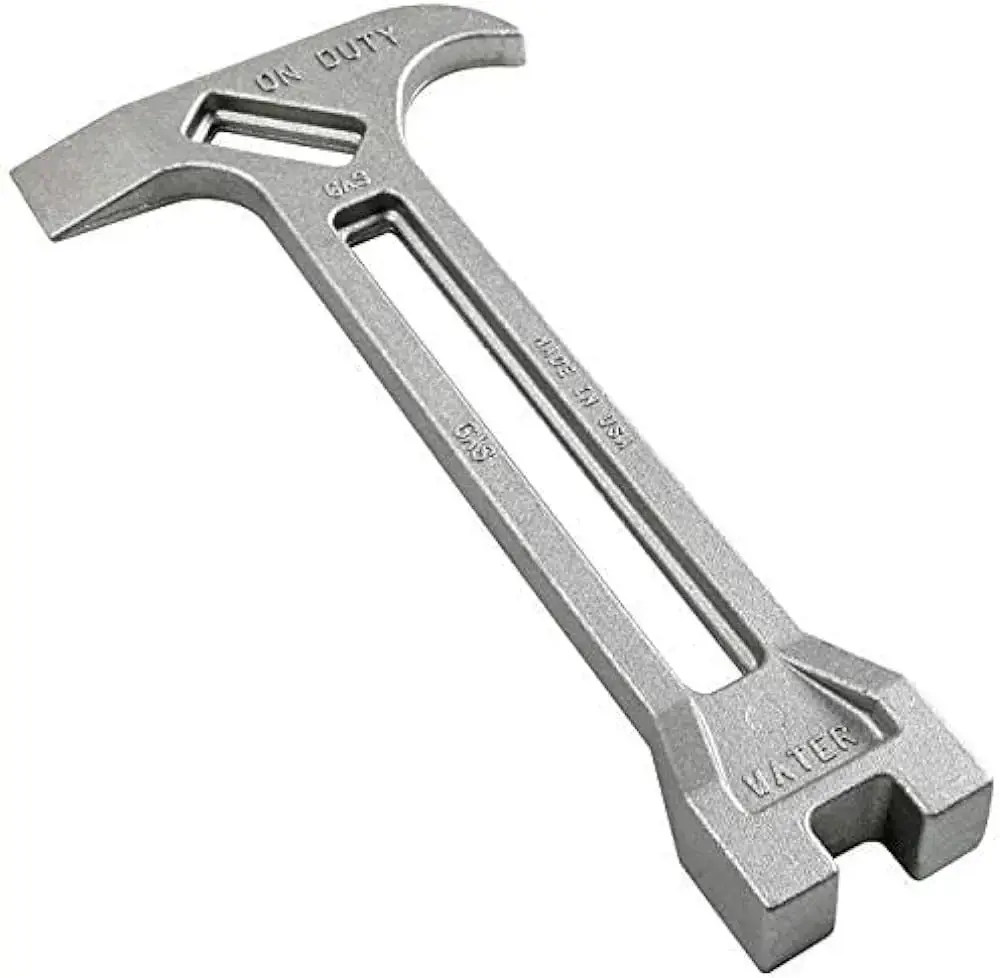
When it comes to preparing for emergencies, having the right tools and equipment can make a significant difference. In the event of debris blocking your way or doors becoming stuck, having the necessary tools in your emergency kit can help you navigate through the situation safely and effectively. Here are some tools and equipment that should be included in your emergency kit to deal with potential debris or door obstructions:
- Multi-tool: A multi-tool is a versatile and handy tool that combines several functions in one, such as pliers, screwdrivers, and a knife. It can be used to cut through ropes, wires, or any other material that may be obstructing your path. Additionally, it can be used to remove screws or pry open doors if needed.
- Bolt cutters: Bolt cutters are heavy-duty cutting tools designed to cut through metal chains, locks, or padlocks. In an emergency situation, bolt cutters can be used to remove barriers or cut through debris blocking your way.
- Pry bar: A pry bar, also known as a crowbar, is a useful tool for opening or forcing doors. It can be used to create leverage and pry open doors that may be jammed or obstructed. Additionally, a pry bar can help you remove debris or objects that may be blocking your path.
- Rope or cord: Including a length of strong rope or cord in your emergency kit can be useful for various purposes. It can be used to tie off or secure items, create makeshift ladders, or assist in removing debris. A sturdy rope or cord can help you navigate through obstacles or pull yourself out of a hazardous situation.
- Shovel: A compact shovel can be invaluable in situations where debris needs to be cleared away, or when digging may be necessary. It can help you clear obstructions, create paths, or dig trenches if needed. A folding shovel is a convenient option for inclusion in your emergency kit as it takes up minimal space.
- Duct tape: Duct tape is known for its versatility and strength. In emergency situations, it can be used to temporarily repair damaged items, reinforce structures, or secure loose objects. It can also be used to patch holes in doors or walls, allowing for easier access.
- Protective gloves and goggles: In any emergency situation, it is important to protect yourself from potential hazards. Including a pair of sturdy gloves and protective goggles in your emergency kit is essential. They can provide protection against sharp objects, debris, or harmful substances while handling tools or clearing debris.
It is important to note that while these tools and equipment can be beneficial in emergency situations, proper training and understanding of their usage is crucial. Additionally, it is essential to regularly inspect and maintain your emergency kit to ensure that all tools and equipment are in good working order. It is recommended to consult with experts or emergency preparedness guides for specific recommendations based on your location and potential hazards.
Essential Items to Pack for a Memorable Trip to Morocco
You may want to see also

What type of clothing or personal protective equipment should be packed in case of an earthquake?
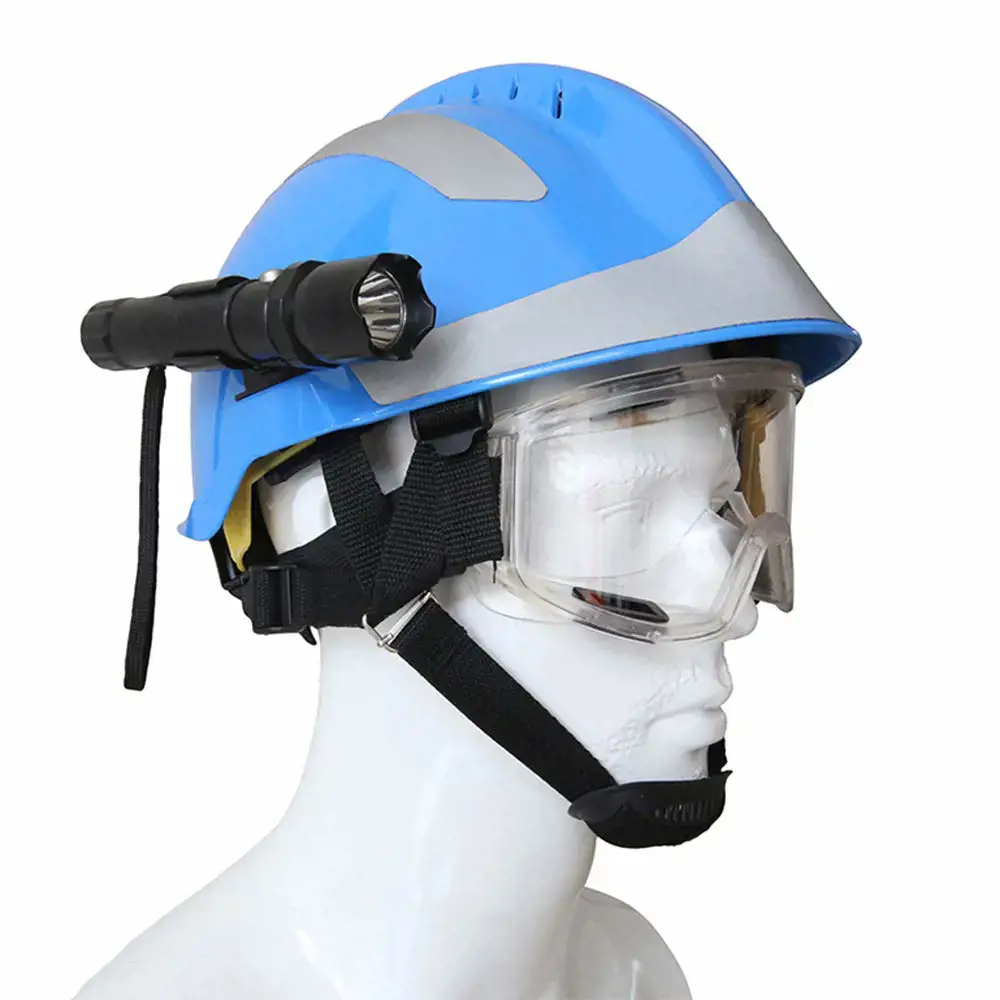
When preparing for an earthquake, it is essential to have a well-stocked emergency kit that includes clothing and personal protective equipment. In the event of an earthquake, you may find yourself without shelter or access to clean water and electricity for an extended period. Having the right clothing and gear can help ensure your safety and comfort during this challenging time.
Clothing: It is crucial to pack durable and comfortable clothing in your earthquake emergency kit. Opt for clothes made from breathable and moisture-wicking fabrics, such as cotton or lightweight synthetic materials. Pack several sets of clothing, including long-sleeved shirts, pants, and underwear. These items will protect your skin from any debris or sharp objects that may be present after an earthquake. Additionally, include a warm jacket or sweater to keep you warm in case temperatures drop.
Footwear: Sturdy, closed-toe shoes are a must-have in your earthquake emergency kit. Avoid open-toed shoes or sandals, as they provide less protection and are more likely to result in injuries. Choose shoes with thick soles and good traction to navigate through potentially hazardous areas safely. If possible, pack an extra pair of shoes or boots in case your primary footwear gets damaged or wet.
Personal Protective Equipment: In addition to clothing, personal protective equipment (PPE) is crucial in an earthquake emergency kit. PPE helps safeguard you from various hazards and allows you to perform certain tasks safely. The following items should be included in your kit:
- Safety Helmet: Protect your head from falling debris by wearing a safety helmet. Choose a sturdy helmet that fits securely and meets safety standards.
- Safety Glasses: Keep your eyes safe from dust, debris, and other potential hazards by wearing safety glasses. Clear or tinted lenses can help protect against sharp objects and harmful substances.
- Dust Mask: In the aftermath of an earthquake, dust, mold, and other airborne particles may be present. A dust mask or respirator will help filter out these contaminants and protect your lungs.
- Gloves: Sturdy work gloves are essential to shield your hands from sharp objects, glass, or other debris. Choose gloves made of durable materials like leather or heavy-duty synthetic materials.
- Flashlight and Batteries: A reliable flashlight is essential for navigating in the dark. Make sure to pack extra batteries to ensure long-lasting light.
Remember to periodically check your emergency kit and replace any expired batteries or outdated items. Consider the specific needs of each family member, including infants, children, and elderly individuals, when packing clothing and personal protective equipment.
In conclusion, packing the right clothing and personal protective equipment is crucial when preparing for an earthquake. Durable clothing and sturdy footwear will protect your body from potential injuries, while personal protective equipment will help safeguard you from hazards and allow you to carry out necessary tasks safely. By being well-prepared, you can ensure your safety and comfort during the aftermath of an earthquake.
Essential Items to Pack for a Memorable Week in Australia
You may want to see also
Frequently asked questions
When packing for an earthquake, it is important to include essential items that can help you survive in the aftermath of the disaster. These items include a first aid kit, non-perishable food and water, a flashlight with extra batteries, a portable radio, a whistle to signal for help, a multi-tool or Swiss army knife, a can opener, a set of clothes (including sturdy shoes and rain gear), a blanket or sleeping bag, personal hygiene items, important documents (such as identification and insurance papers), and any necessary medications.
Yes, it is always a good idea to include tools and supplies in your earthquake preparedness kit. Some useful items to pack include a wrench or pliers (to turn off utilities), duct tape (to secure items or make temporary repairs), a fire extinguisher, a small fireproof safe (to store important documents), waterproof bags or containers to protect valuables and electronic devices, a tarp or plastic sheeting (to create shelter or protect items from rain), and extra batteries for your electronic devices.
While preparing for an earthquake, it is important to consider the needs of your pets as well. Some items to include for your pets in your earthquake preparedness kit include enough food and water for at least three days, a leash and a collar with identification tags, a carrier or crate for transportation, extra bedding or blankets, a first aid kit specifically for pets, any necessary medications, and toys or treats to help keep them calm during the stressful situation. It is also a good idea to have a current photograph of your pet in case they get lost during the earthquake.







